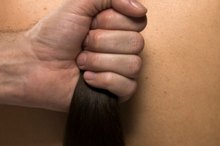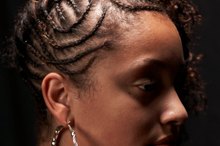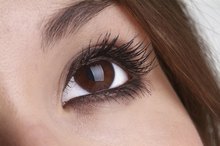How to Make Hair Grow Thicker and Faster
Thin and brittle hair can occur for a number of reasons, including stress, improper diet, improper hair care or genetics. Many times, what makes hair weak and dull are factors within your control. Hair goes through a lot, from styling tools and products to sun exposure and hair chemicals from an array of treatments. These factors can also hinder the growth of hair. You can try several natural and easy methods to make hair grow thicker and faster that are also cost efficient and environmentally friendly.
Rinse hair with apple cider vinegar before your normal shampoo routine two to three times per week. Apple cider vinegar contains many vitamins, but it also balances the pH level of the scalp and removes any dead skin from hair follicles that could be preventing new hair growth.
How to Rub Vitamin E on the Scalp to Promote Hair Growth
Learn More
Make this hair rinse by combining 1 cup of pure apple cider vinegar with 1 cup of distilled water. Pour over dry hair in the shower and massage into the scalp for three to five minutes. Rinse hair with warm water and shampoo as usual.
Mix 1 packet of unflavored gelatin into normal shampoo and use every time you wash your hair. Gelatin is a unique protein that helps hair grow thick and fast.
How to Protect Hair From Falling Out
Learn More
Take a B complex vitamin every day 2. B vitamins prevent hair loss and keep hair strong. Take vitamin A as well to keep the oils in the scalp balanced and hair follicles lubricated to support fast growth.
Eat foods rich in vitamins C and E to boost circulation in the scalp and encourage fast hair growth 2. Citrus fruits contain vitamin C while vegetable oils and nuts are good sources of vitamin E.
Tips
Cook with light vegetable oils such as canola and olive oil to get your daily amount of vitamin E.
B vitamins also work as natural mood stabilizers.
Warnings
Take care not to get apple cider vinegar in the eyes.
Related Articles
References
- Janice Cox; "Natural Beauty at Home"; 1994
- Earl Mindell; "Vitamin Bible for the 21st Century"; 1999
- Amanda Watson; "Natural Beauty: A Step-By-Step Guide"; 1999
- Phillips TG, Slomiany WP, Allison R. Hair Loss: Common Causes and Treatment. Am Fam Physician. 2017;96(6):371-378.
- Watras MM, Patel JP, Arya R. Traditional anticoagulants and hair loss: a role for direct oral anticoagulants? A review of the literature. Drugs Real World Outcomes. 2016;3(1):1-6. doi:10.1007/s40801-015-0056-z
- Urysiak-czubatka I, Kmieć ML, Broniarczyk-dyła G. Assessment of the usefulness of dihydrotestosterone in the diagnostics of patients with androgenetic alopecia. Postepy Dermatol Alergol. 2014;31(4):207-15. doi:10.5114/pdia.2014.40925
- Vincent M, Yogiraj K. A descriptive study of alopecia patterns and their relation to thyroid dysfunction. Int J Trichology. 2013;5(1):57-60. doi:10.4103/0974-7753.114701
- Peters EMJ, Müller Y, Snaga W, et al. Hair and stress: A pilot study of hair and cytokine balance alteration in healthy young women under major exam stress. PLoS ONE. 2017;12(4):e0175904. doi:10.1371/journal.pone.0175904
- Pratt CH, King LE, Messenger AG, Christiano AM, Sundberg JP. Alopecia areata. Nat Rev Dis Primers. 2017;3:17011. doi:10.1038/nrdp.2017.11
- American Academy of Dermatology. Alopecia Areata: Overview.
Writer Bio
Clark Sarullo is an experienced professional writer with expertise in natural skin care, hair care, nutrition, stress management, relaxation techniques, fitness and management of various health conditions. Other areas of expertise include personal finance, money management and debt solutions. Sarullo is based in Atlanta and holds a Bachelor of Science in psychology from the College of Charleston.








